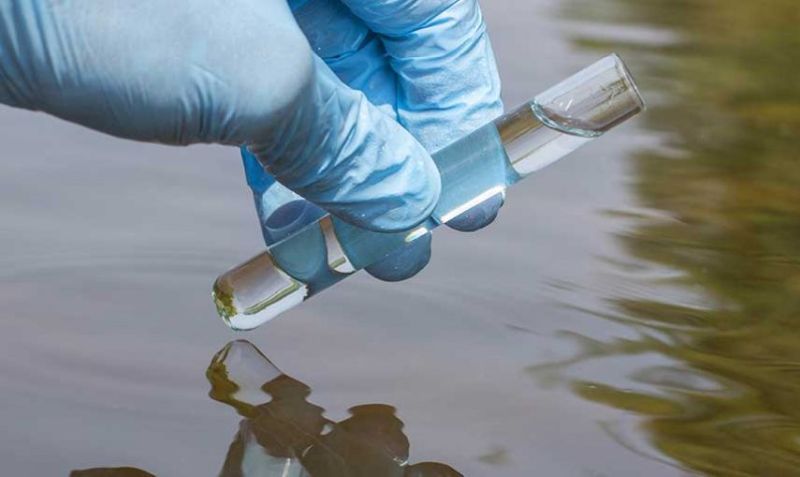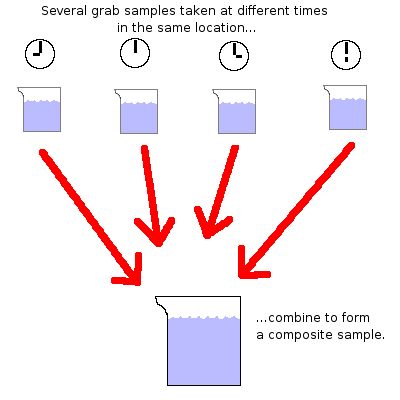Types of Samples
Grab samples and composite samples are the two major types of samples used in water and wastewater treatment. The type of sample taken depends on the sort of test to be conducted, the frequency of testing, and the permit requirements. We’ll go over each test technique in detail below.
Grab Samples

A grab sample, also called a catch sample, is a single sample collected at a given time. This is the most common sort of sample, and it will be used in the majority of your labs. For example, when you gathered a beaker of raw water and checked its pH, you took a grab sample.
There are some restrictions to a grab sample. A grab sample, in essence, is a snapshot of the characteristics of the water at a certain moment and time, and it may not be entirely representative of the full flow. Grab samples are best for small plants with low flows and tiny staffs who can’t sample on a regular basis. Grab samples, on the other hand, provide an immediate sample and are hence preferred for particular tests. Grab samples are preferred for these tests because pH, dissolved oxygen, and total residual chlorine can vary fast in water once the sample is taken from the flow.
Grab samples must be carefully taken in order to be representative of the water as a whole. They should be taken at a time of day when the plant’s average daily flow rate is around. If grab samples are used to measure plant efficiency by collecting raw water and treated water samples, the effluent sample should be collected after the influent sample has been collected long enough to allow the raw water to run fully through the treatment process. Finally, keep in mind that combining two or more grab samples may not yield a result that averages the samples’ properties.
Composite Sample:

A composite sample, also known as an integrated sample, is made up of numerous individual grab samples gathered at regular and predetermined time intervals, each sample taken in proportion to the amount of flow present at the time. Over a longer period of time, composite samples provide a more representative sample of the features of water at the facility.
Composite samples, like grab samples, have advantages and disadvantages and are not suitable for all assays. The ability of composite samples to account for variations in flow and other water parameters over time is their greatest strength. This provides the operator with a comprehensive picture of the whole effects of the influent on the treatment process and the effluent on the receiving water. Composite samples, on the other hand, cannot be used to evaluate water properties that change over time (such as dissolved gases) or water qualities that change when samples are mixed (such as pH.) Table 1060: I in Standard Methods shows which tests are best performed with grab or composite samples.
Automatic sampling machines are frequently used to collect composite samples. These can be programmed to take a sample every 8, 12, or 24 hours, depending on the test needs, treatment plant capacity, and permit requirements.
Oxygen Demand
Oxygen is demanded in wastewater for the oxidation of both inorganic & organic matter. It is expressed in the following ways.
1. Biochemical oxygen demand (BOD):
The oxygen required for microorganisms to carry out the biological breakdown of dissolved solids or organic matter in wastewater under aerobic conditions at normal temperature is referred to as BOD.
The BOD test results are used for the following purposes:
- Calculation of the approximate amount of oxygen required for biological stabilisation of organic materials in the wastewater.
- Establishing the scale of wastewater treatment plants
- Evaluation of the efficacy of some treatment methods.
- Determination of sewage strength
- Calculation of the amount of clear water required for efficient dilution of wastewater.
2. Chemical Oxygen Demand (COD)
It can be calculated in just three hours, compared to five days for a BOD test. A strong chemical oxidizer is employed in an acidic media to quantify the oxygen equivalent of organic matter that can be oxidised in a COD test.
3. Total Organic Carbon (TOC)
It is a metric for determining the amount of organic matter in wastewater. Acidification and aeration of the sample before analysis can prevent errors in the results caused by the presence of inorganic carbon.
4. Demand for Total Oxygen (TOD)
The TOD method is based on the quantitative assessment of the amount of oxygen utilised to burn organic and inorganic substances, to a lesser extent. It is thus a direct assessment of the sample’s oxygen demand.
5. Theoretical Oxygen Demand (ThOD)
It is a mathematical model for calculating the oxygen demand of various organic matter constituents in wastewater. ThOD can be simply computed if the chemical formulas of the elements of organic matter are known.
